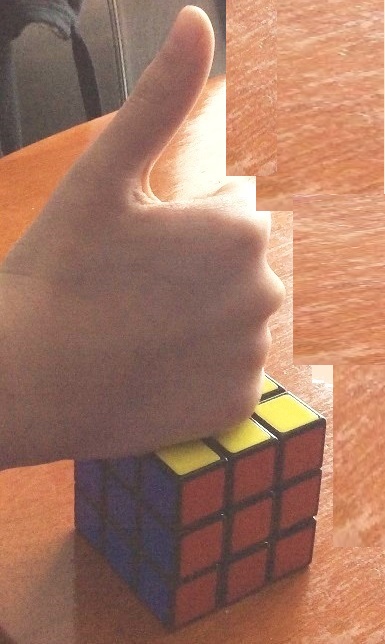Basic Concepts
Each Rubik's Cube is made up of 26 small cubies, organized into three main groups: (why not 27=3x3x3?)
- Centers: There are 6 center pieces on each cube, each visible on one side while the other five sides (of this center piece) remain hidden.
- Edges: The cube has 12 edge pieces, each showing two sides while the other four sides hidden.
- Corners: There are 8 corner pieces, each displaying three sides with the remaining three sides hidden.
- L: left side
- R: right side
- D: down side
- U: upper side
- F: front side
- B: back side
- M: Middle layer (between left and right)
- E: Equatorial layer (between down and up)
- S: Standing layer (between front and back)
Axes, x, y, and z are used for movements beyond the basic sides and layers
Movements can be made into two directions:
- Clockwise (e.g. R)
- Counterclosewise (e.g. R')


Create a 'thumbs-up' gesture with your right hand, placing it on any side of the cube with the thumb facing away from that side. The direction of the other four fingers represents a counter-clockwise movement.
Similarly, create a 'thumbs-up' gesture with your left hand, placing it on any side of the cube with the thumb facing away from that side. The direction of the other four fingers represents a clockwise movement.
For example, the images on the left demonstrate U' (upper side counter-clockwise) and R' (right side counter-clockwise).
Algorithm Symbols
About Rubik's Cube
The Rubik's Cube is a 3-D combination puzzle invented in 1974 by Hungarian sculptor and professor of architecture Erno Rubik , originally called the Magic Cube. Do you know in how many ways we could arrange the cube?
43,252,003,027,486,856,000
That's approximately 43 quintillion.It's very difficult to solve if you just play it blind. It took Rubik himself over a month to solve his own cube.
The Benefits of Solving the Rubik's Cube:
1. Enjoyment: It's a fun and engaging activity.
2. Improved Dexterity: Solving the cube enhances hand flexibility and coordination..
3. Cognitive Exercise: Regular practice keeps your brain active and promotes mental agility.
4. Social Connection: It provides opportunities to connect with others who share your interest.s.
5. Competitive Engagement: The Rubik's Cube is recognized as an official sport, with numerous competitions held globally.ld.
Over all, it's a rewarding and enjoyable experience!
There are tons of videos online. For example:
2014 RUBIK'S CUBE US NATIONAL CHAMPIONSHIPS
BSD Open 2016 Official Competition Rubik's Cube
Embark on your Rubik's Cube journey with this website. Let's get started!
The animations in the website are adpated from Jason Graves.